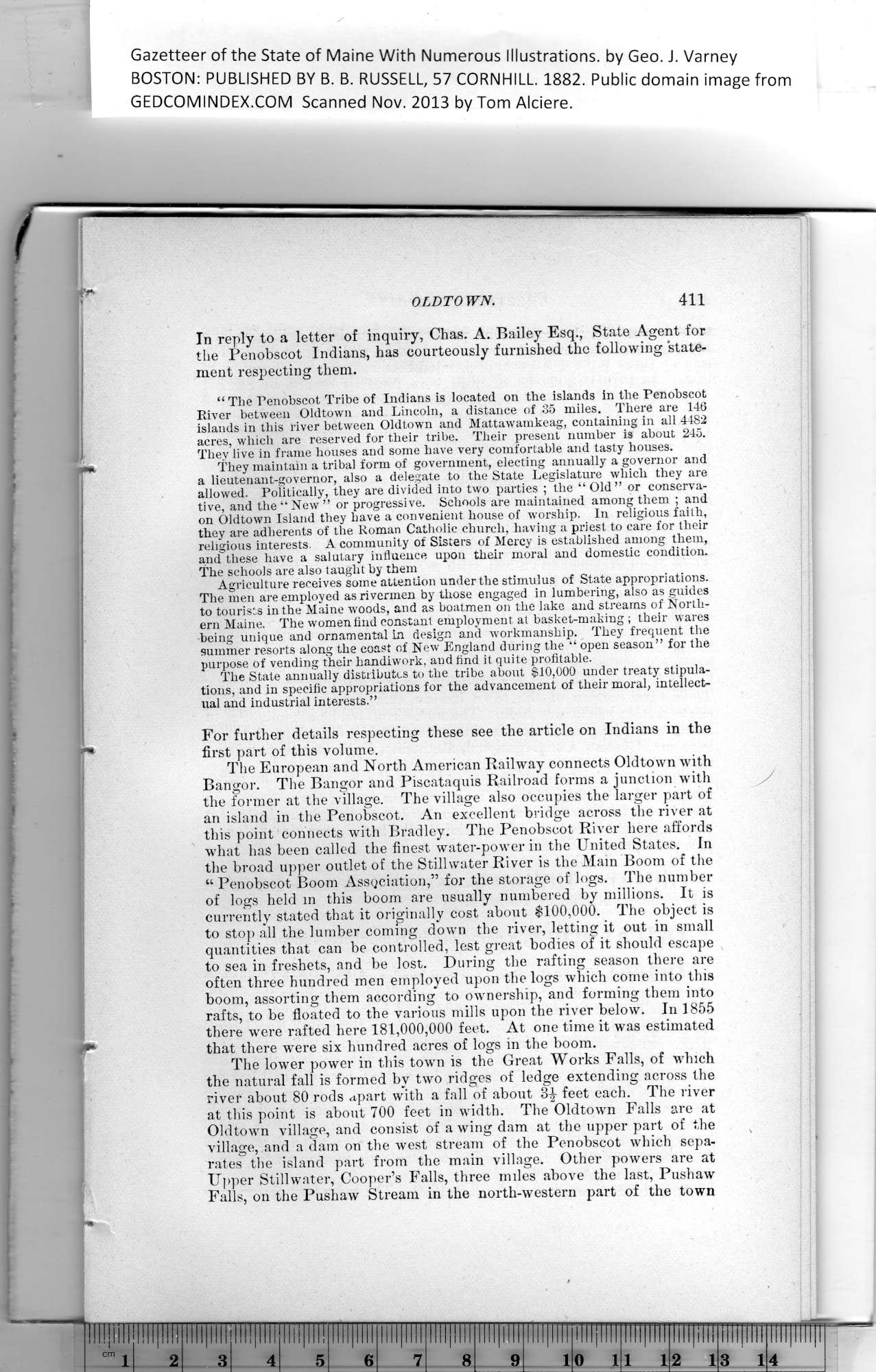|
Gazetteer of the State of Maine With Numerous Illustrations, by Geo. J. Varney
BOSTON: PUBLISHED BY B. B. RUSSELL, 57 CORNHILL. 1882. Public domain image from
' OLDTOWN. 411
j
In reply to a letter of inquiry, Chas. A. Bailey Esq., State Agent for
the Penobscot Indians, has courteously furnished the following state-
ment respecting them.
“ The Penobscot Tribe of Indians is located on the islands in tbe Penobscot
I River between Oldtown and Lincoln, a distance of 35 miles. There are 146
islands in this river between Oldtown and Mattawamkeag, containing in all 4482
acres, which are reserved for their tribe. Their present number is about 245.
J, They live in frame houses and some have very comfortable and tasty houses,
r*. They maintain a tribal form of government, electing annually a governor and
a lieutenant-governor, also a delegate to the State Legislature which they are
allowed. Politically, they are divided into two parties ; the “ Old” or conserva-
tive, and the “New” or progressive. Schools are maintained among them ; and
on Oldtown Island they have a convenient house of worship. In religious faith,
they are adherents of the Roman Catholic church, having a priest to care for their
religious interests. A community of Sisters of Mercy is established among them,
and these have a salutary influence upon their moral and domestic condition.
The schools are also taught by them
Agriculture receives some attention under the stimulus of State appropriations.
The men are employed as rivermen by those engaged in lumbering, also as guides
to tourists in the Maine woods, and as boatmen on the lake and streams of North-
ern Maine. The women find constant employment at basket-making ; their wares
being unique and ornamental in design and workmanship. They frequent the
summer resorts along the coast of New England during the “ open season” for the
purpose of vending their handiwork, aud find it quite profitable.
The State annually distributes to the tribe about $10,000 under treaty stipula-
tions, and in specific appropriations for the advancement of their moral, intellect-
ual and industrial interests.”
For further details respecting these see the article on Indians in the
first part of this volume.
The European and North American Railway connects Oldtown with
Bangor. The Bangor and Piscataquis Railroad forms a junction with y
the former at the village. The village also occupies the larger part of
an island in the Penobscot. An excellent bridge across the river at
this point connects with Bradley. The Penobscot River here affords
what has been called the finest water-power in the United States. In
the broad upper outlet of the Stillwater River is the Mam Boom of the
“ Penobscot Boom xAssqciation,” for the storage of logs. The number
of logs held in this boom are usually numbered by millions. It is
I currently stated that it originally cost about $100,000. The object is
j to stop all the lumber coming down the river, letting it out in small
quantities that can be controlled, lest great bodies of it should escape
to sea in freshets, and be lost. During the rafting season there are
often three hundred men employed upon the logs which come into this
boom, assorting them according to ownership, and forming them into
rafts, to be floated to the various mills upon the river below. In 1855
there were rafted here 181,000,000 feet. At one time it was estimated
that there were six hundred acres of logs in the boom.
| The lower power in this town is the Great Works Falls, of which
i the natural fall is formed by two ridges of ledge extending across the
| river about 80 rods upart with a fall of about feet each. The river
at this point is about 700 feet in width. The Oldtown Falls are at
Oldtown village, and consist of a wing dam at the upper part of the
village, and a dam on the west stream of the Penobscot which sepa-
rates the island part from the main village. Other powers are at
Upper Stillwater, Cooper’s Falls, three miles above the last, Pushaw
Falls, on the Pushaw Stream in the north-western part of the town
PREVIOUS PAGE ... NEXT PAGE
This page was written in HTML using a program written in Python 3.2
| 